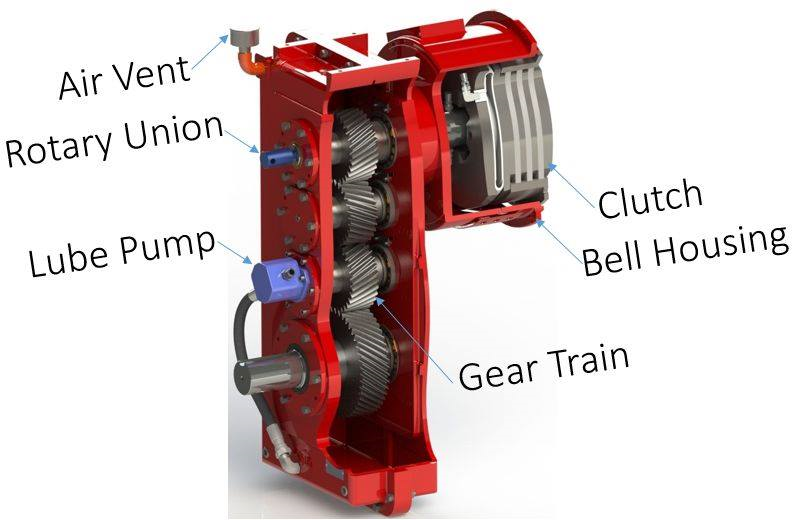-
How to Select a Gearbox

Steps to Selecting a Gearbox
Custom gearboxes are increasingly common, mainly because they’re easier than ever to manufacture to specification.
That’s not to say that the design work isn’t challenging. New machine tools, automation and design software now let OEMs and end users get reasonably priced gearing even in modest volumes.
When requesting help from a gearbox manufacturer or consultant, there are several questions that need to be answered that will more likely provide you with a gearbox that mounts properly and performs to specification.
Below are some of the questions that typically would be asked:
- What’s the input speed to the gearbox?
- What’s the input horsepower?
- What’s the gearbox target output speed or output torque? This partially defines the required gear ratio.
- What are the characteristics of use? How many hours per day will the gearbox run? Will it need to withstand shock and vibration?
- How overhung is the load? Is there internal overhung load? Remember that bevel gears usually can’t accommodate multiple supports, as their shafts intersect … so one or more gears often overhang. This load can deflect the shaft which misaligns the gears, in turn degrading tooth contact and life. One potential fix here is straddle bearings on each side of the gear.
- Does the machine need a shaft or hollow-bore input … or a shaft or hollow-bore output?
- How will the gearing be oriented? Parallel, right angle, planetary, vertically mounted, etc. For instance, if specifying a right-angle worm gearbox, does the machine need the worm over or under the wheel? Will the shafts protrude from the machine horizontally or vertically?
- What type of system will the gearbox be used in? Envelope, space, environment, mechanical characteristics of the whole system, performance of the system, etc. It’s important to understand the other equipment that will be used in the overall system. Some systems will require a heat exchanger to cool the gearbox, and a provision might be made to allow for temperature sensors to measure the gearbox temperature if the gearbox is heating up or cooling off. If measuring movement or misalignment in the gearbox is necessary, then provisions for a vibration sensor can be made as well
- Does the environment necessitate corrosion-resistant paints or stainless-steel housing and shafts?
Service factor: The starting point for most gearbox manufacturers is to define a service factor. This adjusts for such concerns as type of input, hours of use per day, and any shock or vibration associated with the application. An application with an irregular shock (a grinding application, for example) needs a higher service factor than one that’s uniformly loaded. Likewise, a gearbox that runs intermittently needs a lower factor than one used 24 hours a day.
Type of service: Once the engineer determines the service factor, the next step is to define a class of service. A gearbox paired to a plain ac motor driving an even load.
This information comes from charts from gearbox manufacturers that list types of service. To use these charts, the design engineer must know input horsepower, application type and target ratio.
Overhung load: After the designer picks a size, if the load in an application exceeds the allowed value, increase the gearbox size to withstand the overhung load.
Mounting: At this point, the designer or manufacturer has defined the gearbox size and capability. So, the next step is to pick the mounting. Gearbox manufacturers offer many options for each unit size. A flanged input with hollow bore for a C-frame motor combined with an output shaft projecting to the left may be the most common mounting, but there are many other choices. Options such as mounting feet for either above or below the body of the gearbox, hollow outputs, and input and output configuration are all possible. All gearbox manufacturers list their mounting options, as well as dimensional information in websites.
Lubricant, seals and motor integration: Once unit size and configuration is complete, a few specifications remain. Most manufacturers do not ship gearboxes filled with lubrication. This is left to the users to fill them on site. For applications where there is a vertical shaft down, some manufacturers recommend a second set of seals. Finally, because many gearboxes eventually mount to a C-frame motor, many manufacturers also offer to integrate a motor onto the gearbox and ship the assembly as a single unit.
It’s best to work with the manufacturers’ design team or consultants and even use custom gear designs if the application needs a unique motor-gearbox combination. Some combinations are more efficient. In fact, working with manufacturers to get a pre-engineered gearbox ensures that the motor-gearbox combination will work and deliver the specifications from calculations and testing performed by the manufacturer. Review the manufacturer’s performance calculations to determine if the chosen gearbox will cause any issues within the application.
Remember that today’s custom and standard gearing aren’t mutually exclusive. Where fully-custom gearboxes aren’t feasible (if quantities aren’t high enough, for example) consider working with manufacturers that sell gearboxes built to order from standard modular subcomponents. Otherwise, for small quantities of true custom gearboxes, look for manufacturers that leverage the latest CAD software, CAM software and machine tools to streamline post-processing work and reduce the cost of one-offs.
Once the gearbox has been chosen and installed in the application, perform several test runs in sample environments that replicate typical operating scenarios. If the design exhibits unusually high heat, noise or stress, contact the manufacturer or repeat the gear-selection process.


 1-815-874-8110
1-815-874-8110




